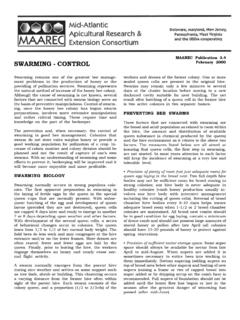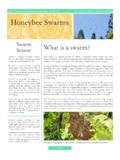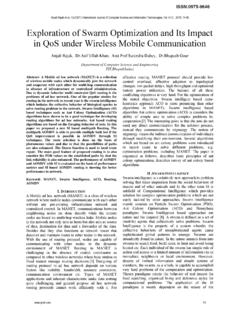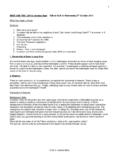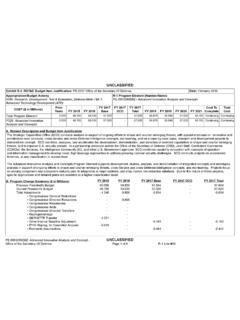Transcription of Tick Management Handbook - ct.gov
1 Tick Management Handbook A integrated guide for homeowners, pest control operators, and public health officials for the prevention of tick-associated disease Prepared by: Kirby C. Stafford III Chief Scientist The Connecticut Agricultural Experiment Station, New Haven Produced as part of the Connecticut community-based Lyme disease prevention projects in cooperation with the following Connecticut health agencies: The Connecticut Department of Public Health The Westport Weston Health District The Torrington Area Health District The Ledge Light Health District Funding provided by The Centers for Disease control and Prevention The Connecticut Agricultural Experiment Station This Handbook was developed as part of a community-based program for the prevention of tick-borne illness supported through a cooperative agreement with the Centers for Disease control and Prevention (CDC). The CDC funded publication of this tick Handbook .
2 A series of tick and tick-associated disease information sheets first developed by Dr. Kirby Stafford at the Connecticut Agricultural Experiment Station in 1992 and updated and expanded periodically was the original basis for this Handbook . Acknowledgements Thanks are given to Dr. Joseph Piesman (CDC, Fort Collins, Colorado), Dr. Peter J. Krause (University of Connecticut Health Center, Farmington, Connecticut), Carol Lemmon (CAES, retired), Bradford Robinson (Connecticut Department of Environmental Protection, Pesticide Management Division), Judith Nelson, Director, and the staff of the Westport Weston Health District (CT), Dr. Terry Schulze (NJ), Dr. Gary Maupin (CDC, retired), and Drs. Louis A. Magnarelli and John F. Anderson (CAES) for reviewing parts or all of this Handbook . Their comments and suggestions were sincerely appreciated. Thanks are also extended to Vickie Bomba-Lewandoski (CAES) for publication and printing assistance. Photo Credits Many of the pictures and illustrations are those of the author or staff at the Connecticut Agricultural Experiment Station (CAES).
3 Sources other than the author are numbered or otherwise noted in captions. Sincere thanks are given to the following for permission to use their photographs or illustrations and federal government sources are also gratefully acknowledged. Pfizer Central Research (Groton Point Road, Groton, CT): 1, 6, 7, 8, 9, 11, 12, 20, 21, 23, 24, 25, 26, 32, 33, 34, 37, 47, 48. Centers for Disease control and Prevention: 13, 14, 16, 17, 19, 27, 28, 29, 30, 36, risk map. United States Department of Agriculture: Cover (tick), tick morphology figure (adapted from Strickland et al. 1976), 39. American Lyme Disease Foundation (Somers, NY): 3, 4, 10, 43. Barnstable County Cooperative Extension (Massachusetts): 40. Vector-borne Disease Laboratory, Maine Medical Center Research Institute (Portland, ME): 15. Bayer Environmental Science (Montvale, NJ): 46. United Industries (Spectrum Brands): 38. Ric Felton (Goshen, CT; ): 35. Jim Occi (Cranford, NJ): 5, 18, 45.
4 Lynne Rhodes (Old Saybrook, CT): 22, 23. Steven A. Levy, DMV (Durham, CT): 31. CAES: Jeffrey S. Ward, 2; Uma Ramakrishnan, 41, 42; and Jeffrey Fengler, 44. Disclaimer Mention of a product or company is for informational purposes only and does not constitute an endorsement by the Connecticut Agricultural Experiment Station. Published Summer 2004 2004 The Connecticut Agricultural Experiment Station Table of Contents Ticks of the Northeastern United Tick biology and Tick Blacklegged tick, Ixodes American dog tick, Dermacentor Lone star tick, Amblyomma Other Tick-Associated Lyme Southern Tick-Associated Rash Human Human Ehrlichiosis ..23 Rocky Mountain Spotted Tick Tularemia ..26 Powassan Tick-borne Relapsing Fever ..27 Colorado Tick Bartonella Lyme Disease in Companion Personal Tick bite How a tick bites & Tick Integrated Tick Landscape Management of host Prevention of tick-associated disease in companion Backyard Wildlife programs and environmentally friendly Area-wide Chemical control of Acaricides used for tick Homeowner application of Commercial application of An acaricide primer.
5 58 Organic Landcare Biological Selected The Connecticut Agricultural Experiment StationTo these I must add the wood lice [ticks] with which the forests are so pestered that it is impossible to pass through a bush or to sit down, though the place be ever so pleasant, without having a whole swarm of them on your clothes. Pehr Kalm, 18 May 1749 Raccoon [Swedesboro], New Jersey Introduction Ticks have become an increasing problem to people and animals in the United States. Ticks are obligate blood-feeders that require an animal host to survive and reproduce. They feed on a wide variety of mammals, birds, reptiles, and even amphibians. While most ticks feed on specific host animals and are not considered to be of medical or veterinary importance, several ticks have a wide host range and attack people, pets, or livestock. Ticks can be a nuisance; their bites can cause irritation and, in the case of some ticks, paralysis. Severe infestations on animals can cause anemia, weight loss, and even death from the consumption of large quantities of blood.
6 Ticks can also transmit many human and animal disease pathogens, which include viruses, bacteria, rickettsiae, and protozoa. 1 The association between ticks and disease was first demonstrated when Theobald Smith and Fred Kilbourne proved in 1893 that Texas cattle fever (cattle babesiosis) was caused by a protozoan transmitted by an infected tick. In the late 1800s, Rocky Mountain spotted fever was the first human tick-borne disease identified in the United States and for many years was the major tick-associated disease in this country. Although first recognized from the virulent cases in the Bitterroot Valley of Montana, it eventually became evident that most cases were distributed through the eastern United States. Lyme disease was first recognized as a distinct clinical entity from a group of arthritis patients in the area of Lyme, Connecticut, in 1975, although it became evident that this disease had an extensive history in Europe throughout the twentieth century.
7 Today, Lyme disease is the leading arthropod-associated disease in the United States with over 23,000 human cases reported to the Centers for Disease control and Prevention (CDC) in 2002. This may represent only about 10% of physician-diagnosed cases. Surveys have found that up to a quarter of residents in Lyme disease endemic areas have been diagnosed with the disease and that many residents perceive the disease as a serious or very serious problem. Without an effective intervention strategy, the steadily increasing trend in Lyme disease case reports is likely to continue. In the northeastern United States, the emergence of Lyme disease can be linked to changing landscape patterns. A Swedish naturalist named Pehr Kalm recorded in his journal of his travels in the United States in 1748-1750 that ticks were abundant and 1 The Connecticut Agricultural Experiment Stationannoying. Over a century later in 1872, entomologist Asa Fitch noted that ticks were nearly or quite extinct along the route that Pehr Kalm had traveled.
8 During this time, the land had been cleared for agriculture and white-tailed deer in many areas were drastically reduced or virtually eliminated due to habitat loss and unregulated hunting. With the reestablishment of forested habitat and animal hosts through the latter half of the twentieth century, ticks that may have survived on islands off the southern New England coast were able to increase and spread. The blacklegged tick, Ixodes scapularis, which is commonly known as the deer tick, and the principal vector for Lyme disease spirochetes, was present on Naushon Island, Massachusetts, in the 1920s and 1930s. Some I. scapularis from Montauk Point, Long Island, New York, that were collected in the late 1940s and early 1950s were found infected with Lyme disease bacteria. The risk of human infection increased through the 1960s and 1970s until the recognition of the disease from the cluster of cases in Lyme, Connecticut, in 1975. The rising incidence of Lyme disease is due to a number of factors including: 1880190019201940196019802000In Thousands020406080 Estimated Deer Numbers in Connecticut Increased tick abundance Overabundant deer population Increased recognition of the disease Establishment of more residences in wooded areas Increased the potential for contact with ticks.
9 An estimated three quarters of all Lyme disease cases are acquired from ticks picked up during activities around the home. With the steady increase in the incidence and geographic spread of Lyme disease, there is a need for homeowners, public health officials, and the pest control industry to learn how to manage or control the tick problem. The withdrawal of the human Lyme disease vaccine (LYMErix ) has essentially brought the control of the disease back to managing tick bites and methods to suppress the local tick population or prevalence of pathogen infection in the ticks. The purpose of this Handbook is to provide basic information on ticks and their biology, basic information on the diseases they carry, methods to reduce the risk of exposure to these parasites, and most importantly, information on how to reduce or manage tick populations, and therefore risk of disease, in the residential landscape. 2 2 The Connecticut Agricultural Experiment StationTicks: the foulest and nastiest creatures that be.
10 Pliny the Elder, 23-79 Ticks of the Northeastern United States Ticks are not insects, but are arthropods more closely related to mites, spiders, scorpions, and daddy-long-legs. There are about 80 species of ticks in the United States (850 species worldwide). However, only about 12 or so in the are of major public health or veterinary concerns with a few others that occasionally attack humans. The ticks discussed in this Handbook belong to the family Ixodidae or hard ticks. The principal hard ticks recovered from humans in the mid-Atlantic and northeastern United States are the blacklegged ( , deer) tick, Ixodes scapularis, the American dog tick, Dermacentor variabilis, and the lone star tick, Amblyomma americanum. Other tick species recorded as feeding on humans in the eastern include Ixodes cookei, Ixodes dentatus, and the brown dog tick, Rhipicephalus sanguineus. The Argasidae or soft ticks form the other major group of ticks. Soft ticks are generally nest inhabitants that are associated with rodents, birds, or bats.










